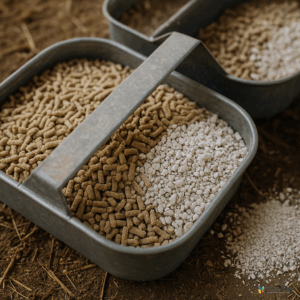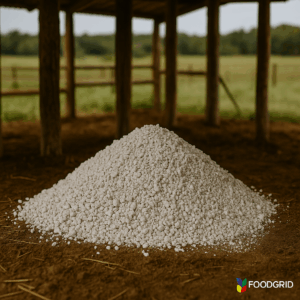For commercial poultry operations, every gram of calcium counts. Poor calcium utilization doesn’t just waste money—it compromises eggshell strength, reduces skeletal integrity, and undermines flock performance. With feed costs rising and export markets demanding compliance with additive regulations, feed formulators are under pressure to get calcium right.
Calcium salts—whether in carbonate, lactate, or advanced high-solubility forms—offer a proven path to improve mineral bioavailability, optimize feed efficiency, and safeguard long-term productivity. This guide provides a step-by-step, research-backed approach to incorporating calcium salts into poultry feed formulations for maximum results.
Why Calcium Matters in Poultry Nutrition
Poultry layers require 2–4% calcium in compound feeds to sustain egg production and skeletal health. Calcium’s role spans two critical areas:
- Eggshell Formation: More than 95% of an eggshell is calcium carbonate. Insufficient or poorly absorbed calcium leads to thin shells, breakage, and production losses.
- Skeletal Strength: Calcium supports bone density in high-lay flocks, reducing skeletal stress, fractures, and culling rates.
But calcium nutrition is more than simply meeting percentage targets. The form, solubility, and timing of calcium delivery dictate how efficiently birds absorb and utilize the mineral.
Forms of Calcium Salts Used in Poultry Feed
Feed formulators typically rely on the following sources:
Calcium Carbonate
- Most common form, widely available, cost-effective.
- Granulated forms improve eggshell quality; micronized versions enhance digestibility.
Calcium Lactate
- Higher solubility than carbonate, suitable for starter diets and specialty applications.
Advanced Soluble Options (e.g., ReliaCal)
- Designed for optimal flowability and blending in premixes.
- Higher bioavailability reduces waste and improves return on investment.
- Each option has trade-offs in terms of cost, handling, and performance. A strategic combination often yields the best outcomes.
Practical Considerations for Feed Formulators
- Calcium Solubility and Absorption
- Challenge: Inconsistent absorption leads to brittle shells and variable production.
- Solution:
- Use granulated calcium carbonate for slow release during the night when shell formation peaks.
- Add micronized or lactate forms for rapid absorption, especially in high-producing flocks.
- Particle Size and Flowability
- Fine powders improve solubility but cause dust and flowability issues.
- Granulated forms reduce dust, improve handling, and ensure consistent mixing in 25–50 kg bag applications.
- Balancing Calcium and Phosphorus
- Excess calcium interferes with phosphorus absorption, leading to skeletal issues.
- Ideal Ca:P ratio: 2:1 in layer diets.
- Formulators should use digestibility coefficients, not just total mineral percentages, to fine-tune balance.
- Regulatory Compliance
- Export markets often require EU-approved calcium sources (E170).
- Compliance ensures market access while preventing costly feed recalls.

Research-Backed Outcomes
- Eggshell Strength: Studies show that incorporating a mix of coarse and fine calcium carbonate increases shell thickness and reduces breakage by up to 20% (University of Georgia Extension).
- Bone Health: Granulated calcium sources improve tibia ash content, supporting skeletal resilience in high-lay hens (NRC, 1994).
- Feed Efficiency: High-solubility salts improve calcium retention, lowering excretion and environmental load (Iowa State Extension, 2019).
Common Challenges and Solutions
1. Brittle Eggshells
- Cause: Poor calcium source solubility or incorrect timing.
- Fix: Blend coarse and fine particle calcium sources; include soluble salts like lactate.
2. Dust in Premixes
- Cause: Use of micronized calcium carbonate.
- Fix: Switch to granulated forms or coat particles to improve flowability.
3. Phosphorus Interaction
- Cause: High dietary calcium suppresses phosphorus utilization.
- Fix: Balance Ca:P ratio carefully, and consider using phytase enzymes to liberate bound phosphorus.
4. High Waste and Excretion
- Cause: Low bioavailability of standard calcium carbonate.
- Fix: Adopt high-solubility sources like ReliaCal for better efficiency.
Economic ROI of Calcium Salt Optimization
- Eggshell Breakage: A 2% reduction in breakage can save $20,000–30,000 per year in a 100,000-hen operation.
- Bone Integrity: Reduced culling translates to longer productive cycles and lower replacement costs.
- Feed Efficiency: Higher bioavailability reduces waste minerals, cutting disposal and environmental costs.
On average, incorporating optimized calcium salts delivers a 3–5x return on investment, making it one of the most cost-effective interventions in poultry feed formulation.

Supplier and Sourcing Insights
- Purchase Formats: 25–50 kg bags, often in granulated or micronized forms.
- Global Suppliers: Trusted names include Carmeuse and GLC Minerals.
- Buying Strategy: Large commercial mills often procure via tenders. Preference for suppliers with EU compliance certification for global export readiness.
- Product Example: High-solubility sources like ReliaCal are favored for easy blending and consistent performance.
Feeding Guidelines
- Layer Diets: Maintain 3.5–4.0% calcium in feed.
- Broiler Breeders: Provide sufficient calcium for skeletal integrity—target 2% dietary inclusion.
- Particle Size Strategy: 30–40% coarse particles for sustained release overnight & 60–70% fine or soluble particles for rapid absorption.
- Monitoring: Track shell thickness, tibia ash, and excreta calcium to evaluate effectiveness.
References
- NRC (National Research Council). (1994). Nutrient Requirements of Poultry: Ninth Revised Edition. Washington, DC: National Academies Press. Available at: https://nap.nationalacademies.org/catalog/2114/nutrient-requirements-of-poultry-ninth-revised-edition-1994
- University of Georgia Extension. “Calcium Nutrition and Eggshell Quality in Layers.” Available at: https://extension.uga.edu/publications/detail.html?number=B1234
- Iowa State University Extension. “Calcium and Phosphorus in Poultry Nutrition.” Available at: https://www.extension.iastate.edu/
- Poultry Science Association. “Mineral Nutrition of Poultry.” Available at: https://www.poultryscience.org/
Internal Resources
For more insights on optimizing feed strategies, explore FoodGrid’s resources:
- FoodGrid Home: https://foodgridinc.com/
- FoodGrid Blog: https://foodgridinc.com/foodblog/
Are you ready to enhance eggshell quality, reduce waste, and strengthen flock performance with calcium salt solutions?
👉 Partner with FoodGrid for premium calcium additives designed for poultry feed efficiency and compliance.
Contact us today to discuss formulations, sourcing, and tender support.
